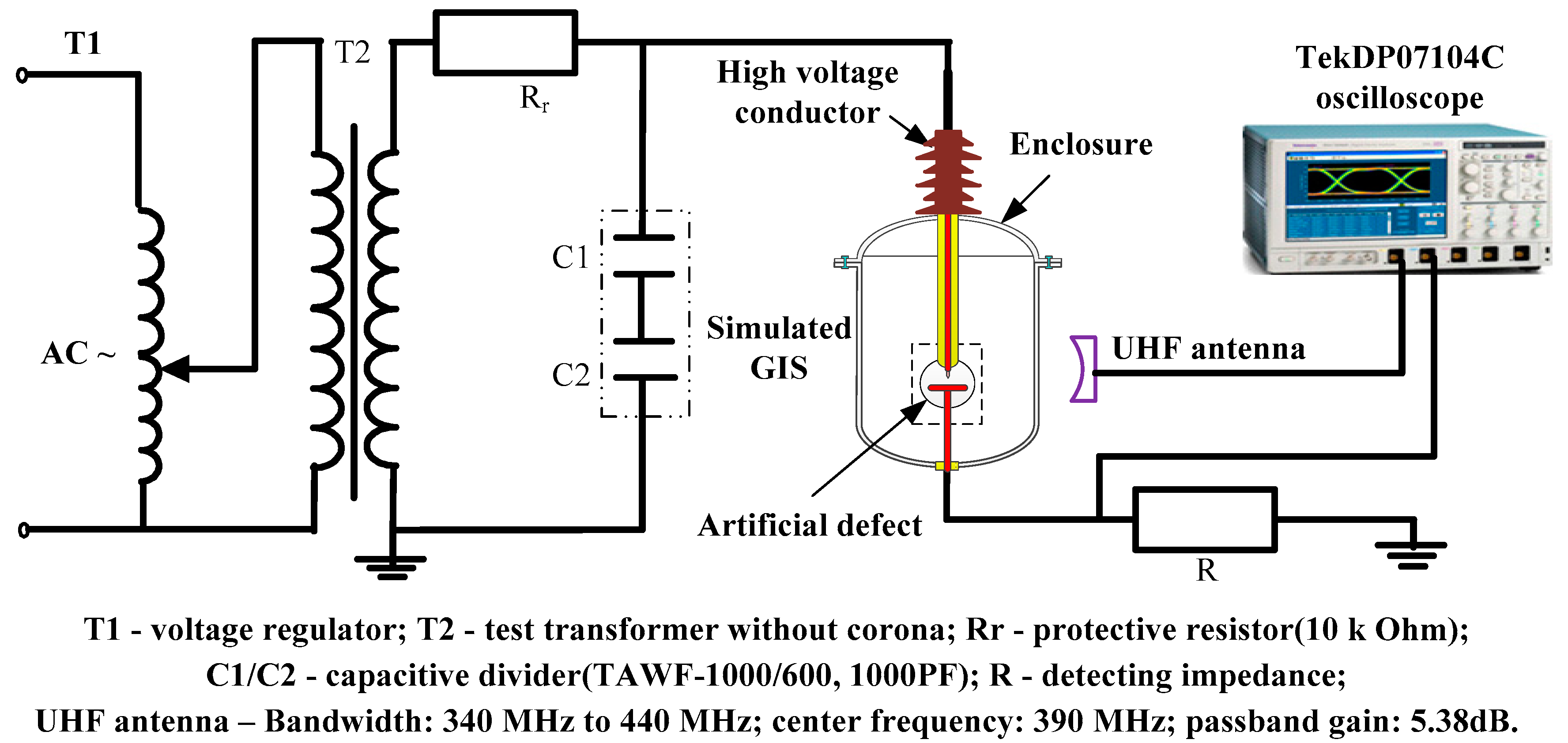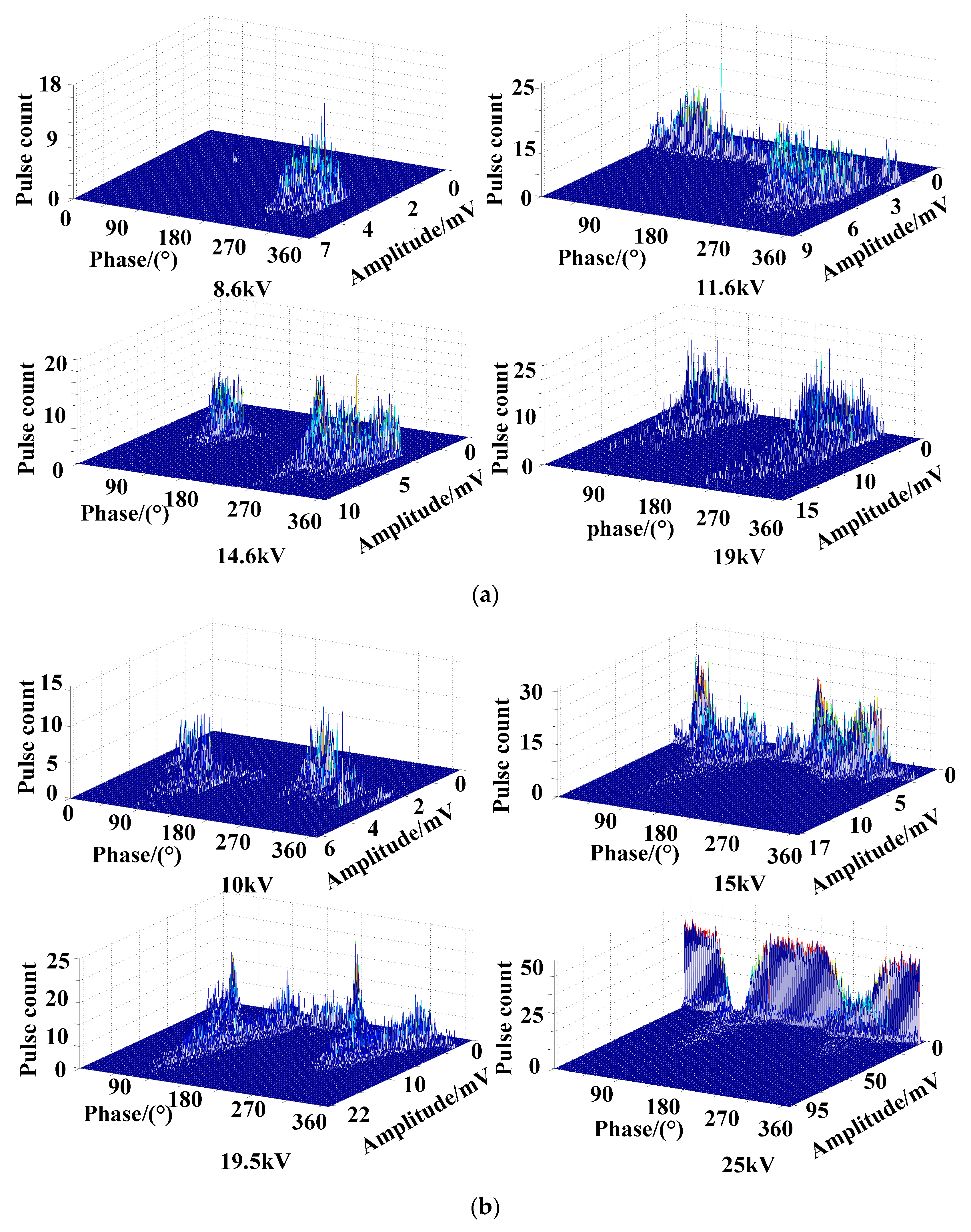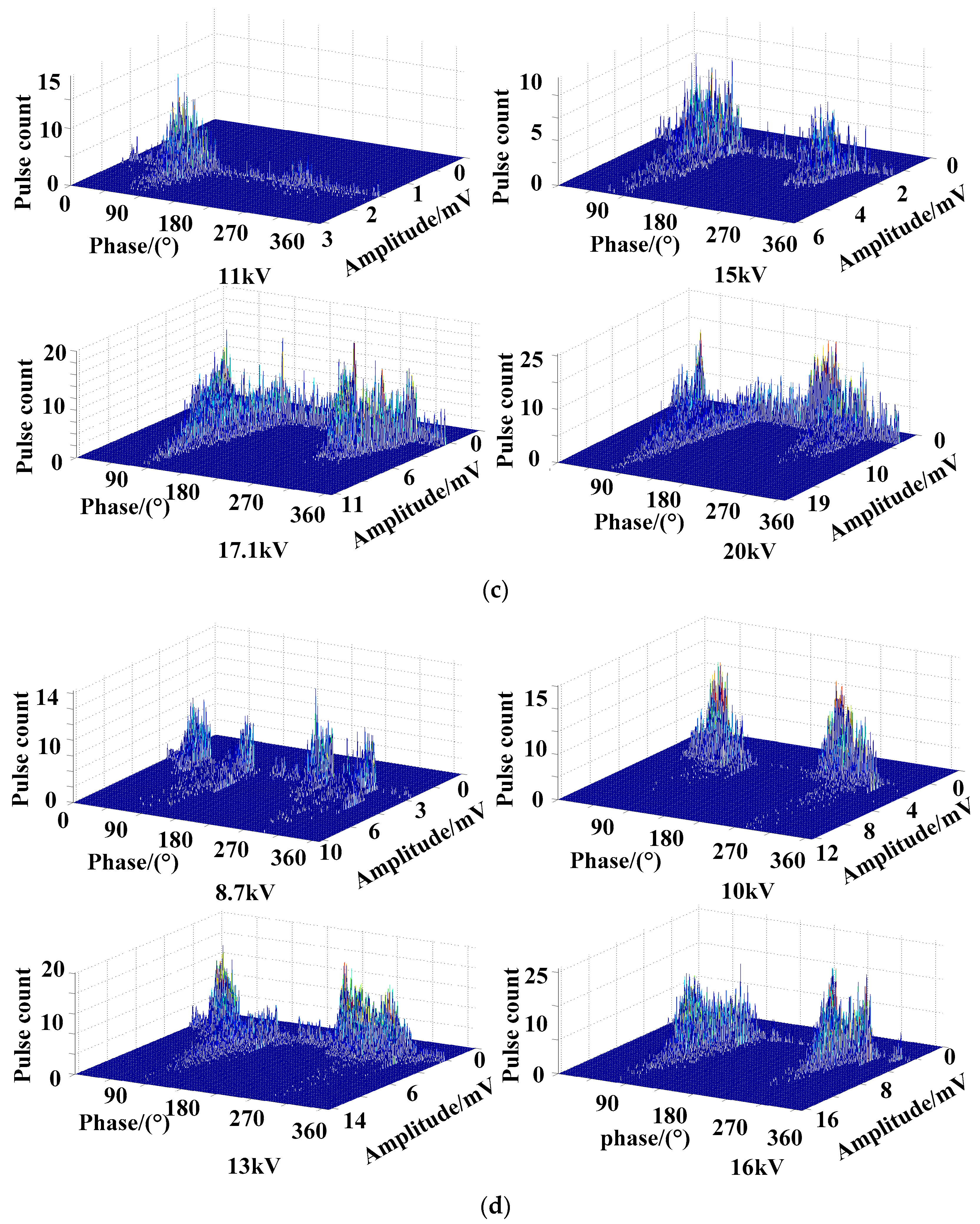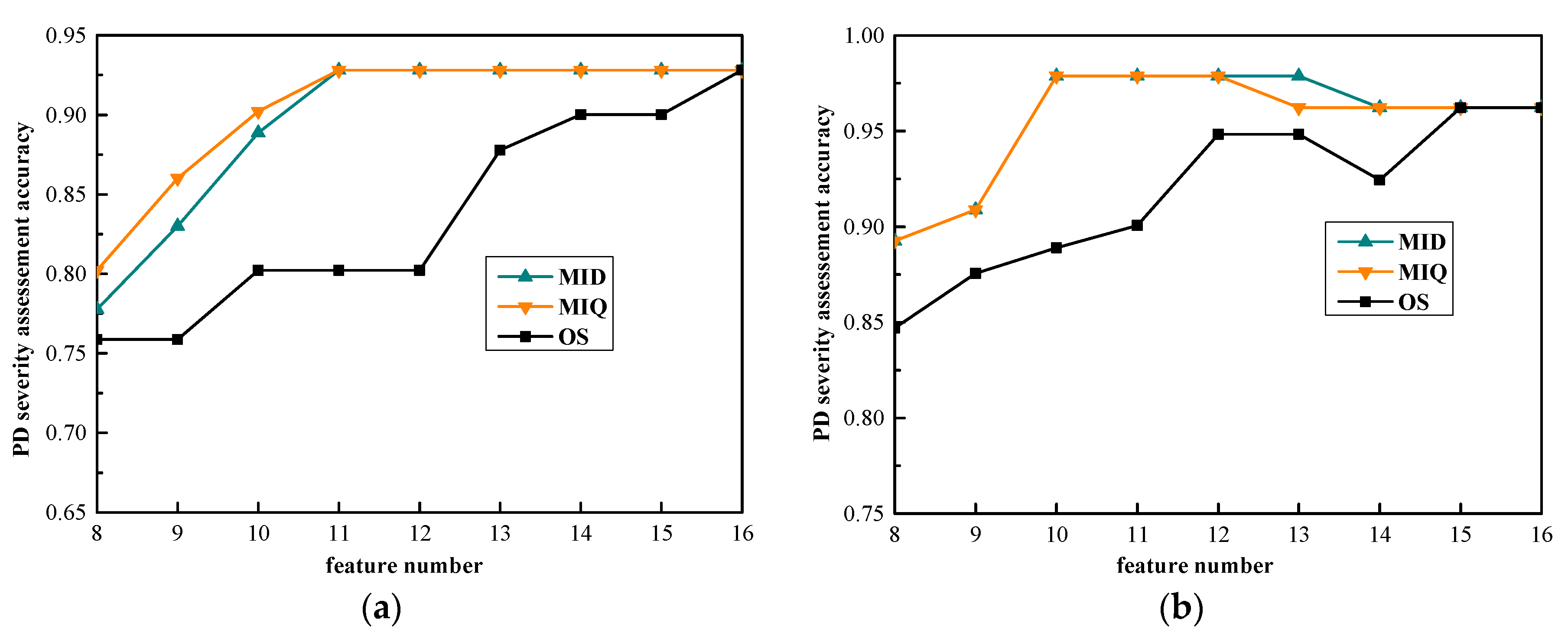Feature Selection for Partial Discharge Severity Assessment in Gas-Insulated Switchgear Based on Minimum Redundancy and Maximum Relevance
Abstract
:1. Introduction
2. Experiment
2.1. Experimental Implementation and Method
2.2. PD Data Acquisition and Analysis
- (1)
- In the N defect, the development is observed from almost no discharge to discharge and finally being close to discharge intensity of negative half cycle with PD deterioration in the positive half cycle. This step indicates using a change of discharge position to differentiate PD severity of the N defect, which is more advantageous than the three other kinds of defects.
- (2)
- The discharge amplitude fluctuation in the G defect is significant, and this feature information is more obvious in G than that in the three other kinds of defects.
- (3)
- Discharge times, amplitude, and position of the P and M defects do not change significantly, like the N and G defects, during PD development. Compared with the M defect, the change of the aforementioned characteristics is less obvious for the P defect.
3. Statistical Features for PD Development
3.1. Statistical Features under the PRPD Mode
3.2. PD Severity Assessment Features Based on Theoretical Study
3.3. Definition of PD Severity Stage
4. Feature Selection Based on the mRMR Method
4.1. mRMR Principle
4.2. PD Severity Assessment Feature Selection Model Designs
- Original PD database construction. Based on the analysis of the 3D PD-pattern and the characteristics of the four types of defects in Table 1, the PD severity state of the four typical defects are summarized in Table 5. From the information, we can extract the corresponding dataset of the four defined states for the four defined defects.To remove the physical unit interference of the extracted features, based on quantitative analysis, the data of all the features are normalized to [0, 1]. The following normalized preprocessing method is adopted:where, and are the original signal and the normalized signal, respectively, and and represent the minimum and maximum values of the input signal, respectively.
- Disposal of feature data discretization. The extraction features in this paper are continuous variables and, thus, require discrete processing. The normalized feature data are divided into different intervals to achieve the discretization of the continuous quantity [25].
- PRPD features set construction. The process of the collected original PD data is based on statistical formulas in PRPD [23] mode and building of the PRPD feature set.
- Optimal feature set selection: The size of optimal feature set is defined, and MID and MIQ search rules are used to obtain the optimal feature set and feature sort number of each defect, respectively.
- Evaluation effect test: The classifier and the ratio of sample training set and test set, which are suitable for the research, need to be chosen before the test. Then, the optimal feature set is defined as the input of the chosen classifier for recognizing the PD severity state.
5. PD Severity Assessment Test
5.1. PD Severity Assessment Feature Selection Model Designs
5.2. PD Severity Evaluation Effect Test Based on mRMR Method
5.3. PD Severity Evaluation Effect Comparison with Features from the mRMR Method and Theoretical Analysis
6. Conclusions
- The theory analysis of the 3D PD-pattern under four defects in different discharge states in Section 3.1 shows that with regard to the representation of PD severity, the sequence of the influence degree of the statistical features, such as discharge time, amplitude, and position, in evaluating the severity of different defects is inconsistent. The ordering result of the optimal feature subset under PRPD mode acquired through MID and MIQ searching rules in Section 5.1 provides excellent verification for the 3D PD-pattern analysis from the data level.
- The PD severity evaluation accuracy comparison results of the MID feature set, MIQ feature set, and the OS feature set with a SVM classifier indicates the original PRPD feature set includes feature items that exert minimal representation effect on PD severity under the four defined defects and are even involved in redundant feature items under the P and G defects. The first 10 or 11 features in the MID feature set, or the MIQ feature set, can obtain the same PD severity evaluation effect from the original 16D feature set.
- The PD severity evaluation effect comparison between the features set selected by mRMR algorithm and statistical features set extracted based on theoretical analysis indicates that PD severity assessment accuracy with the optimal feature set has a higher stability of precision than the traditional feature set, in engineering applications under all defined defects. The similar PD severity assessment accuracy of the SVM classifier and the BPNN classifier based on feature show that the PD selection process for deep PD information mining plays a more important role than the classifier selection.
Acknowledgments
Author Contributions
Conflicts of Interest
References
- Mas’Ud, A.A.; Albarracín, R.; Ardila-Rey, J.A.; Muhammad-Sukki, F.; Illias, H.A.; Bani, N.A.; Munir, A.B. Artificial Neural Network Application for Partial Discharge Recognition: Survey and Future Directions. Energies 2016, 9, 574. [Google Scholar] [CrossRef]
- Metwally, I.A. Status review on partial discharge measurement techniques in gas-insulated switchgear/lines. Electr. Power Syst. Res. 2004, 69, 25–36. [Google Scholar] [CrossRef]
- Ma, H.; Chan, J.C.; Saha, T.K.; Ekanayake, C. Pattern recognition techniques and their applications for automatic classification of artificial partial discharge sources. IEEE Trans. Dielectr. Electr. Insul. 2013, 20, 468–478. [Google Scholar] [CrossRef]
- Tenbohlen, S.; Coenen, S.; Djamali, M.; Andreas, M.; Mohammad, H.S.; Martin, S.D. Diagnostic measurements for power transformers. Energies 2016, 9, 347. [Google Scholar] [CrossRef]
- Okabe, S. Insulation properties and degradation mechanism of insulating spacers in gas insulated switchgear (GIS) for repeated/long voltage application. IEEE Trans. Dielectr. Electr. Insul. 2007, 14, 101–110. [Google Scholar] [CrossRef]
- Raymond, W.J.K.; Illias, H.A.; Bakar, A.H.A.; Mokhlis, H. Partial discharge classifications: Review of recent progress. Measurement 2015, 68, 164–181. [Google Scholar] [CrossRef]
- Ren, M.; Dong, M.; Liu, J. Statistical analysis of partial discharges in SF6 gas via optical detection in various Spectral ranges. Energies 2016, 9, 152. [Google Scholar] [CrossRef]
- Gao, W.; Ding, D.; Liu, W.; Huang, X. Investigation of the Evaluation of the PD severity and verification of the sensitivity of partial-discharge detection using the UHF method in GIS. IEEE Trans. Power Deliv. 2014, 29, 38–47. [Google Scholar]
- Ren, M.; Dong, M.; Liu, Y.; Miao, J.; Qiu, A. partial discharges in SF6 gas filled void under standard oscillating lightning and switching impulses in uniform and non-uniform background fields. IEEE Trans. Dielectr. Electr. 2014, 21, 138–148. [Google Scholar] [CrossRef]
- Qi, B.; Li, C.; Xing, Z.; Wei, Z. Partial discharge initiated by free moving metallic particles on GIS insulator surface: Severity diagnosis and assessment. IEEE Trans. Dielectr. Electr. 2014, 21, 766–774. [Google Scholar] [CrossRef]
- Okabe, S.; Yamagiwa, T.; Okubo, H. Detection of harmful metallic particles inside gas insulated switchgear using UHF sensor. IEEE Trans. Dielectr. Electr. 2008, 15, 701–709. [Google Scholar]
- Sahoo, N.C.; Salama, M.M.A.; Bartnikas, R. Trends in partial discharge pattern classification: A survey. IEEE Trans. Dielectr. Electr. 2005, 12, 248–264. [Google Scholar] [CrossRef]
- Peng, H.; Long, F.; Ding, C. Feature Selection Based on Mutual Information: Criteria of Max-Dependency, Max-Relevance, and Min-Redundancy. IEEE Trans. Pattern Anal. Mach. Intell. 2005, 27, 1226–1238. [Google Scholar] [CrossRef] [PubMed]
- Ahmad, F.; Isa, N.A.M.; Hussain, Z.; Osman, M.K.; Sulaiman, S.N. A GA-based feature selection and parameter optimization of an ANN in diagnosing breast cancer. Pattern Anal. Appl. 2015, 18, 861–870. [Google Scholar] [CrossRef]
- Xu, Y.; Ding, Y.X.; Ding, J.; Wu, L.Y.; Xue, Y. Mal-Lys: Prediction of lysine malonylation sites in proteins integrated sequence-based features with mRMR feature selection. Sci. Rep. 2016, 6, 38318. [Google Scholar] [CrossRef] [PubMed]
- Lima-Mendez, G.; Faust, K.; Henry, N.; Decelle, J.; Colin, S.; Carcillo, F.; Chaffron, S.; Ignacio-Espinosa, J.C.; Roux, S.; Vincent, F.; et al. Ocean plankton. Determinants of community structure in the global plankton interactome. Science 2015, 348, 1262073. [Google Scholar] [CrossRef] [PubMed] [Green Version]
- Ashkezari, A.D.; Ma, H.; Saha, T.K.; Cui, Y. Investigation of feature selection techniques for improving efficiency of power transformer condition assessment. IEEE Trans. Dielectr. Electr. 2014, 21, 836–844. [Google Scholar] [CrossRef]
- Majidi, M.; Fadali, M.S.; Etezadi-Amoli, M.; Oskuoee, M. Partial discharge pattern recognition via sparse representation and ANN. IEEE Trans. Dielectr. Electr. 2015, 22, 1061–1070. [Google Scholar] [CrossRef]
- Majidi, M.; Oskuoee, M. Improving pattern recognition accuracy of partial discharges by new data preprocessing methods. Electr. Power Syst. Res. 2015, 119, 100–110. [Google Scholar] [CrossRef]
- Zhang, S.; Li, C.; Wang, K.; Li, J.; Liao, R.; Zhou, T.; Zhang, Y. Improving recognition accuracy of partial discharge patterns by image-oriented feature extraction and selection technique. IEEE Trans. Dielectr. Electr. 2016, 23, 1076–1087. [Google Scholar] [CrossRef]
- Mas’Ud, A.A.; Stewart, B.G.; McMeekin, S.G. Application of an ensemble neural network for classifying partial discharge patterns. Electr. Power Syst. Res. 2014, 110, 154–162. [Google Scholar] [CrossRef]
- Tang, J.; Zhou, Q.; Tang, M.; Xie, Y. Study on mathematical model for VHF partial discharge of typical insulated defects in GIS. IEEE Trans. Dielectr. Electr. 2007, 14, 30–38. [Google Scholar] [CrossRef]
- Mas’Ud, A.A.; Stewart, B.G.; Mcmeekin, S.G. An investigative study into the sensitivity of different partial discharge φ-q-n pattern resolution sizes on statistical neural network pattern classification. Measurement 2016, 92, 497–507. [Google Scholar] [CrossRef]
- Dong, Y.L.; Tang, J.; Zeng, F.P.; Liu, M. Features Extraction and Mechanism Analysis of Partial Discharge Development under Protrusion. J. Electr. Eng. Technol. 2015, 10, 344–354. [Google Scholar] [CrossRef]
- Kraskov, A.; Stögbauer, H.; Grassberger, P. Estimating mutual informationl. Phys. Rev. E 2004, 69, 066138. [Google Scholar] [CrossRef] [PubMed]
- Robles, G.; Parrado-Hernández, E.; Ardila-Rey, J.; Martínez-Tarifa, J.M. Multiple partial discharge source discrimination with multiclass support vector machines. Expert Syst. Appl. 2016, 55, 417–428. [Google Scholar] [CrossRef]
- Tang, J.; Zhuo, R.; Wang, D.B.; Zhang, X.X. Application of SA-SVM Incremental Algorithm in GIS PD Pattern Recognition. J. Electr. Eng. Technol. 2016, 11, 192–199. [Google Scholar] [CrossRef]






| Defect Type | Voltage Grade (kV) |
|---|---|
| N Class Defect | 7.3→8.6→9.3→10.4→11.6→13.5→14.6→16.4→19.4 |
| P Class Defect | 11.0→12.3→13.6→15.0→16.1→17.1→18.0→19.0→20.0 |
| M Class Defect | 8.7→10.0→11.5→13.0→14.5→16.0→17.5 |
| G Class Defect | 10.0→13.5→15.0→16.5→18.0→19.5→21.0→23.0→25.0→27.0 |
| No. | Features | Description |
|---|---|---|
| 1–6 | , , , , | Skewness of positive half cycle, negative half cycle, and whole cycle. |
| 7–12 | , , , , | Steepness of positive half cycle, negative half cycle, and whole cycle. |
| 13–14 | Amplitude and discharge time ratio between positive and negative half cycles. | |
| 15–16 | Cross-correlation coefficient of positive and negative half cycles. |
| Type | Parameters | Description |
|---|---|---|
| Statistical Features | , | The maximum discharge pulse amplitude in positive and negative positive half-cycle. |
| , | The discharge times in positive and negative positive half-cycle. | |
| Time Interval of Adjacent Discharge | The time interval of two adjacent discharge pulse in positive and negative positive half-cycle. | |
| The maximum time interval of two adjacent discharge pulses in one power cycle. | ||
| Equivalent Cumulative Discharge Quantities | Discharge quantities in a certain period. | |
| Signal Entropy | The PD Information complexity is denoted by signal entropy [19]. |
| State | Definition | Description |
|---|---|---|
| Normal State H1 | Initial Stage of Discharge | Discharge times and amplitude are small, and the positive half-cycle is almost no PD discharge in this state. |
| Attention State H2 | A Slight Discharge | Discharge times, amplitude, Qacc, and En has changed on certain degree, and a small quantity of weak discharge pulses appears in positive half-cycles. |
| Serious State H3 | Serious Stage of Discharge | Discharge times, amplitude, Qacc, and En have obvious changes in this state. |
| Dangerous State H4 | Pre-breakdown | PD discharge in positive half-cycles is no weaker than that in negative half-cycles, and the discharge pulse amplitude is saturated. |
| Defect Types | Corresponding PD States of the Applied Voltage (kV) | |||
|---|---|---|---|---|
| H1 | H2 | H3 | H4 | |
| N Class Defect | 7.3/8.6/9.4 | 11.6/13.5 | 14.6/16.4 | 19.4 |
| P Class Defect | 11/13.6 | 15/16.1 | 17.1/18.0 | 19.0/20.0 |
| M Class Defect | 8.7 | 10.0/11.5 | 13.0/14.5 | 16.0/17.5 |
| G Class Defect | 10/13.5/15 | 16.5/18/19.5 | 21.0/23.0 | 25.0/27.0 |
| Features Number | Feature Search Rules | |
|---|---|---|
| MID | MIQ | |
| 8 | 16, 1, 13, 6, 15, 7, 4, 14 | 16, 1, 13, 6, 14, 15, 7, 4 |
| 9 | 16, 1, 13, 6, 15, 7, 4, 14, 11 | 16, 1, 13, 6, 14, 15, 7, 4, 11, |
| 10 | 16, 1, 13, 6, 15, 7, 4, 14, 11, 3 | 16, 1, 13, 6, 14, 15, 7, 4, 11, 3 |
| 11 | 16, 1, 13, 6, 15, 7, 4, 14, 11, 3, 12 | 16, 1, 13, 6, 14, 15, 7, 4, 11, 3, 2 |
| 12 | 16, 1, 13, 6, 15, 7, 4, 14, 11, 3, 12, 8 | 16, 1, 13, 6, 14, 15, 7, 4, 11, 3, 2, 12 |
| 13 | 16, 1, 13, 6, 15, 7, 4, 14, 11, 3, 12, 8, 10 | 16, 1, 13, 6, 14, 15, 7, 4, 11, 3, 2, 12, 8 |
| 14 | 16, 1, 13, 6, 15, 7, 4, 14, 11, 3, 12, 8, 10, 2, | 16, 1, 13, 6, 14, 15, 7, 4, 11, 3, 2, 12, 8, 10 |
| 15 | 16, 1, 13, 6, 15, 7, 4, 14, 11, 3, 12, 8, 10, 2, 5 | 16, 1, 13, 6, 14, 15, 7, 4, 11, 3, 2, 12, 8, 10, 5 |
| 16 | 16, 1, 13, 6, 15, 7, 4, 14, 11, 3, 12, 8, 10, 2, 5, 9 | 16, 1, 13, 6, 14, 15, 7, 4, 11, 3, 2, 12, 8, 10, 5, 9 |
| Defect Type | Feature Search Rule | |
|---|---|---|
| MID | MIQ | |
| N Class Defect | 16, 1, 13, 6, 15, 7, 4, 14, 11, 3, 12, 8, 10, 2, 5, 9 | 16, 1, 13, 6, 14, 15, 7, 4, 11, 3, 2, 12, 8, 10, 5, 9 |
| G Class Defect | 13, 15, 3, 11, 16, 14, 1, 12, 2, 9, 10, 7, 8, 6, 5, 4 | 13, 9, 15, 1, 14, 11, 16, 3, 12, 2, 10, 7, 6, 8, 5, 4 |
| M Class Defect | 14, 16, 5, 15, 13, 1, 4, 7, 9, 12, 6, 8, 10, 3, 11, 2 | 14, 5, 16, 13, 15, 1, 4, 7, 9, 12, 8, 6, 10, 11, 3, 2 |
| P Class Defect | 16, 5, 3, 15, 14, 11, 6, 9, 8, 4, 12, 7, 13, 10, 2, 1 | 16, 5, 6, 15, 14, 11, 3, 9, 8, 13, , 4, 12, 7, 10, 2, 1 |
| State | PD Severity Assessment Accuracy (%) | |||||||||||
|---|---|---|---|---|---|---|---|---|---|---|---|---|
| -SVM | -SVM | -BPNN | ||||||||||
| N | P | M | G | N | P | M | G | N | P | M | G | |
| H1 | 0.92 | 0.95 | 0.90 | 0.92 | 0.89 | 0.81 | 0.76 | 0.81 | 0.91 | 0.90 | 0.88 | 0.90 |
| H2 | 0.90 | 0.92 | 0.88 | 0.98 | 0.72 | 0.80 | 0.70 | 0.95 | 0.89 | 0.89 | 0.86 | 0.95 |
| H3 | 0.88 | 0.88 | 0.85 | 0.88 | 0.79 | 0.80 | 0.72 | 0.80 | 0.86 | 0.88 | 0.85 | 0.87 |
| H4 | 0.82 | 0.91 | 0.82 | 0.92 | 0.80 | 0.83 | 0.80 | 0.83 | 0.83 | 0.92 | 0.80 | 0.90 |
| ALL | 0.88 | 0.92 | 0.85 | 0.93 | 0.77 | 0.81 | 0.80 | 0.83 | 0.87 | 0.90 | 0.84 | 0.91 |
© 2017 by the authors. Licensee MDPI, Basel, Switzerland. This article is an open access article distributed under the terms and conditions of the Creative Commons Attribution (CC BY) license (http://creativecommons.org/licenses/by/4.0/).
Share and Cite
Tang, J.; Jin, M.; Zeng, F.; Zhou, S.; Zhang, X.; Yang, Y.; Ma, Y. Feature Selection for Partial Discharge Severity Assessment in Gas-Insulated Switchgear Based on Minimum Redundancy and Maximum Relevance. Energies 2017, 10, 1516. https://doi.org/10.3390/en10101516
Tang J, Jin M, Zeng F, Zhou S, Zhang X, Yang Y, Ma Y. Feature Selection for Partial Discharge Severity Assessment in Gas-Insulated Switchgear Based on Minimum Redundancy and Maximum Relevance. Energies. 2017; 10(10):1516. https://doi.org/10.3390/en10101516
Chicago/Turabian StyleTang, Ju, Miao Jin, Fuping Zeng, Siyuan Zhou, Xiaoxing Zhang, Yi Yang, and Yan Ma. 2017. "Feature Selection for Partial Discharge Severity Assessment in Gas-Insulated Switchgear Based on Minimum Redundancy and Maximum Relevance" Energies 10, no. 10: 1516. https://doi.org/10.3390/en10101516





